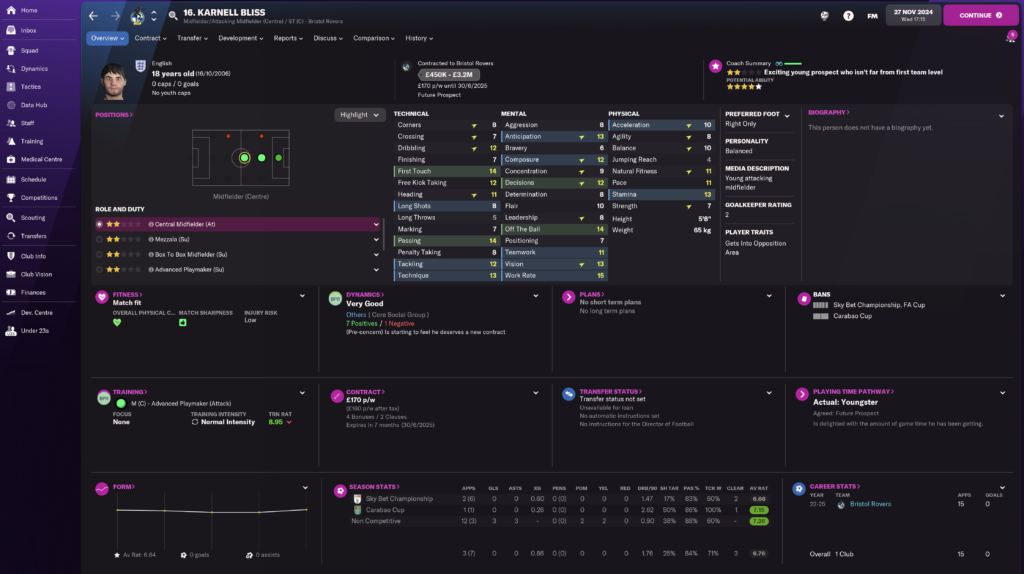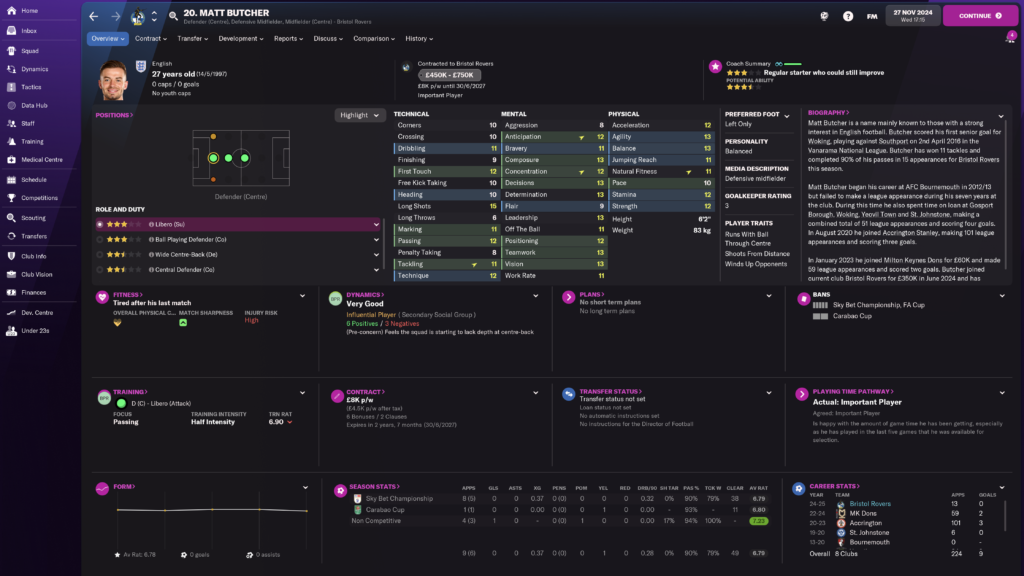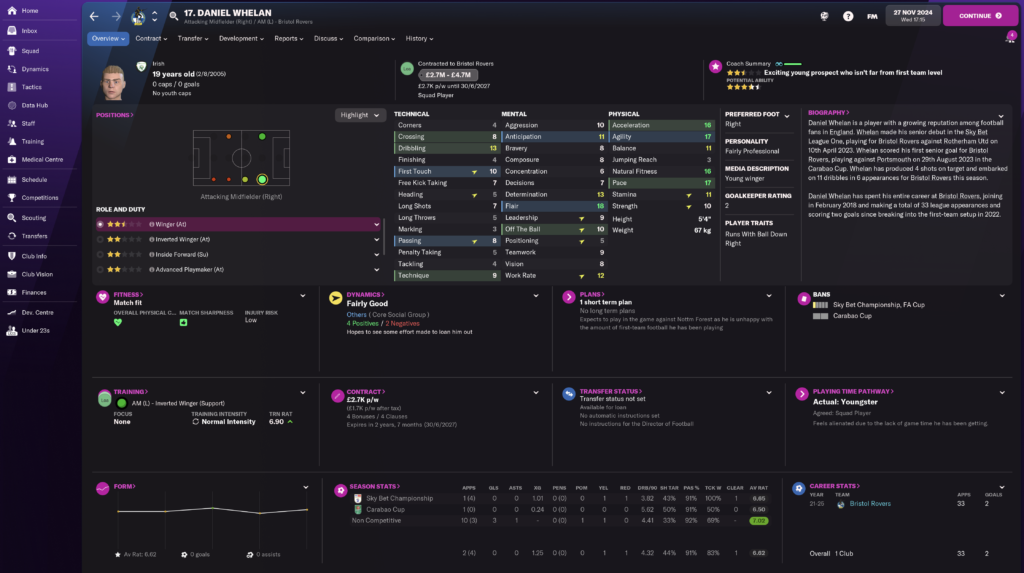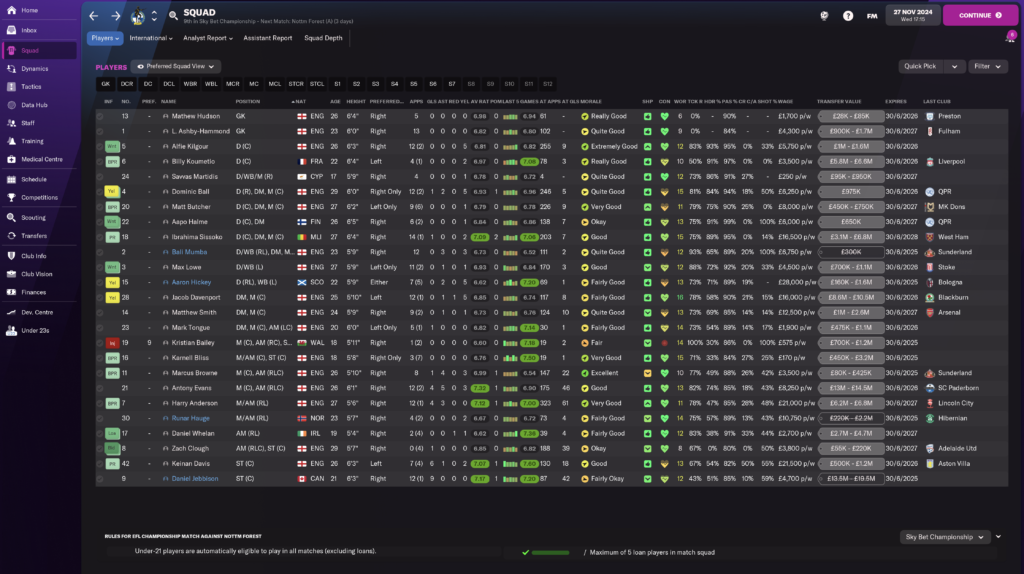V is for Football Manager Versatility by @FMLogos_rocheyb
One of the more important aspects of our pretend jobs as Football ManagersTM is the business of squad building. It’s all very well and good to spend truckloads of somebody else’s cash on constructing a stellar First XI, but if the backup players under your leadership can’t catch a cold, pass water, cross a road, etc., or half your squad is prone to slip a disc every time they sneeze, then you’re in for a very difficult season.
Injuries and suspensions are an inevitable feature of every campaign, and the temptation—especially when your ambitions are being sugar-daddied up the wazoo by a blindly benign benefactor with more money than sense—is always to amass a huge squad large enough to account for every potential pitfall.
Premier League rules allow you to have no more than 25 players above the age of 21, and the presence of quality young players who are not yet so well-established as to expect permanent first-team football is one useful strategy for managing your way through the ups and downs of a season. In the lower divisions, where I tend to begin my saves, you are allowed to have larger squads but sign too many players who all want to play in the same position. You will soon have a mutiny on your hands as player after player beats a path to your office door to demand more game time, at the expense of one or more of their colleagues.
What you need is a generous sprinkling of versatile players—those jacks-of-all-trades who can be deployed in several positions without significantly weakening your team.
Out here in the real world, James Milner is probably the archetypal Mr. Versatile. In his youth with Leeds United and Newcastle United, he was often a wide midfielder who could play on either flank, while in his time at Manchester City and Liverpool, he has usually played in central midfield and occasionally at full-back. Having him in the squad on any given matchday presented his real-life manager with tactical possibilities that other, less versatile players don’t necessarily offer.
Throughout his reign at Old Trafford, Sir Alex Ferguson always found a place in his squads for less celebrated players who could come in and do a job whenever needed. Phil Neville was a competent full-back but possibly more effective as a defensive midfielder; Ji-Sung Park was a workhouse, whether operating from either flank, through the middle as a forward, or in a dedicated man-marking role of the type that could even nullify a force as strong as Andrea Pirlo.
In my own FM saves, I’m a firm devotee of the 4-3-3 formation. I like my full-backs to get forward; typically, I’ll go for an attacking left-back and a right-back in support mode. A defensive midfielder is my team’s Steady Eddie at the base of the midfield, with a box-to-box midfielder alongside a more creative advanced playmaker operating from the M (C) position. I don’t have much truck with No. 10s; I’ve rarely been able to get the best out of the temperamental gits!
On the flanks, my left-winger can be an inside forward or an inverted winger, allowing space for my left-back to exploit on the wing. While, on the right-hand side, I favour a good old-fashioned winger, raiding the byline and putting crosses in at will—and plundering his fair share of goals.
Up front, I’m happy to have either a target man, an advanced forward, or a pressing forward, depending on the capabilities of the players at my disposal, and I will swap the role around from game-to-game to suit whichever player is fit and firing enough to take the starting slot for a particular match.
Sometimes, though, my team will struggle to find a way past their opponents, and I might want to switch to an alternative formation. In my current save with Bristol Rovers (still in FM22), my backup tactic is a 5-3-2, which allows me to pair two goal-getters up front, push my wing-backs into more aggressive roles, and add a libero who can step out from defence to initiate attacking moves.
Having players in my squad who can switch positions, roles, and duties on my whim means that I can swap from 4-3-3 to 5-3-2 with just one substitution—or sometimes two, depending on who exactly made the starting XI this time out. Knowing this in advance means that when scouring the transfer market, I will often favour players who can play to the best of their ability in at least two positions that are relevant to my preferred tactical schemes. And, when a promising young player pokes his head above the parapet of the youth intake, I’m quick to assess his strengths and weaknesses in relation to my way of playing, and I’ll do my best to mould him to fit a couple of roles.

Take my current wonderkid, the beautifully monikered Karnell Bliss. He came in as part of the recent season’s youth prospects as a celebrated No. 10. But as I already mentioned, I don’t like No. 10, so I immediately started retraining him to play as an advanced playmaker from the central midfield position. That was already one of his less-powerful positional options, but with dedicated retraining and increasing exposure in my Bristol Rovers first team, now playing in the Championship, he is still on course to realise his potential.
I didn’t actually know it until I took the screenshot of him to illustrate this article, but if you look at his profile, you can see that his M (C) role is now in the same bright green as his original No. 10/AM (C) rating, which confirms that his football re-education is going well. He’s also hard at work developing the individual trait to Try Killer Balls Often, which suits my preferred tactic.
Despite my usual aversion to them, I have in the past used tactics that feature a No. 10 I’ve used the asymmetrical 4-5-1 that has a No. 10 slotting in behind a lone central striker with some success, so if I decide to experiment with that one again, young Master Bliss should suit that system. He has also done well for the U23s as a striker on occasion, so I might yet retrain him in one of those roles to add another string to his bow.

One of my more recent signings for the princely sum of £375,000 is the former Accrington Stanley player Matt Butcher. In reality, he joined Plymouth Argyle in the summer of 2022; in my save, he had two seasons with MK Dons before I brought him to the Memorial Stadium. He turned up in my player search for a libero, but he’s equally at home as a ball-winning defensive midfielder or in central midfield, either as a ball-winner or a box-to-box man. He’s a great option for the bench when I’m playing my usual 4-3-3, and he comes into his own when I swap to the three-at-the-back option.
I have clicked on his avatar during the match animation, which I watch on the Comprehensive View; hence, it takes me so long to play a save that I will often skip a new FM release to continue enjoying my existing game for another year. When he gets on the ball in his deep position at the heart of my defence with space to move ahead of him, he brings the ball into midfield and looks to find a more advanced, attacking player. Runs with Ball Through Centre was already listed among his player traits, and I now have him working on his fondness for the Switch Ball to Wide Areas move. Meanwhile, regular involvement in the team when we’re playing 4-3-3 means that he maintains his ability to play in those other roles, too.

My Bristol-born Irishman, Daniel Whelan, is another product of The Gas’s youth academy. He’s a right winger who I’m steadily moulding into an inverted winger in the AM (L) slot. He’s only 5’4” and he’s a violent little sod with a tendency to launch two-footed tackles; he already has two red cards to his name. I’m trying to curb that overexuberance, but, in the meantime, I’m also encouraging him to Cut Inside from the Left Wing so he can attack more effectively from that side. He has done it in flashes during games, and having a player who I can swap from one wing to the other or name on the bench to provide cover for two players at once, is obviously useful. His recent form hasn’t been particularly good and he will have to buck his ideas up to remain part of my long-term plans. For the time being, though, his versatility makes him a useful asset.
My preference for attacking full-backs and the two systems I work with mean that I always favour one who lists D/WB (R) or (L) as his preferred positions, over the kind of full-back who can also operate as a centre-back. And ball-winning midfielders who play in both the defensive midfield and central midfield slots give you options about how high up the pitch you want your players to seriously engage the opposition in trying to win back possession. Another of my youth players who is on the verge of the first-team squad can play as a Regista in the defensive midfield position, so it’s useful to have a ball-winning midfielder who can slot in ahead of him to maintain some muscle in my midfield when he plays.
Despite my best efforts, I do sometimes have players complain about not getting enough first-team football. For the most part, that’s usually because I don’t think they’re good enough and I can often resolve the situation by putting them on the transfer list or sending them out on loan. But, by operating a slightly smaller squad with plenty of players who can play in different positions and roles, I keep my options open while also keeping everyone involved. I have learned, though, to look out for players inserting position and role stipulations into contract negotiations, and I think I have saved myself some potential future headaches by removing those requests before those deals got done.
Versatile players also help, of course, to deal with the occasional inevitable injury crisis or that jumbled period throughout December and the New Year when there is another football match to play every three days. You can let star players rest occasionally, safe in the knowledge that you have a capable replacement to take his place for a game or two.

My Bristol Rovers won League Two in my first season, and then we were runners-up in League One the following season. We finished just outside the promotion play-off spots in the championship, despite being in the top 3 at New Year. I was glad not to win promotion right away because we’re not strong enough for the Premier League yet. My fourth season has been a bit less successful than I was expecting; we’re 9th after 16 matches. But I have four teenagers in my first team squad who are all developing nicely, and after a change of ownership last season, I have the funds to improve my squad one position at a time, and enough grace and favour from the Board for my past successes to take my time over identifying the right players to bring in.
That’s another advantage of having versatile players in the squad, especially when a good number of them have come through your club’s own youth ranks. Imagine you had to buy a whole new squad from scratch: 25 players at an average cost of £5 million per player (somewhat above my current spending capability, but for the sake of this thought experiment), with the aim of having two players for every position in your preferred tactic, plus a few specialists who suit your secondary system.
Each time you bring a player forward from the youth ranks, you save your transfer kitty £5 million, which then raises the average amount you can spend on a reduced number of players. And, if enough of the players you buy or internally promote can play alternative positions, you can reduce the need for additional back-ups. For example, if you have three first-team-quality wingers who can all operate on both the right and left flanks, a fourth player might struggle to get game time. But a promising young winger coming through the youth ranks can become that fourth option. He’s a lot less likely to complain about being left out for a while, and you can retrain versatility into him to suit your way of playing, further improving his chances of getting more game time during his eventual long and, hopefully, successful stay at your club.
For previous A-Z entries, please visit: The A-Z of Football Manager.





Leave a Reply